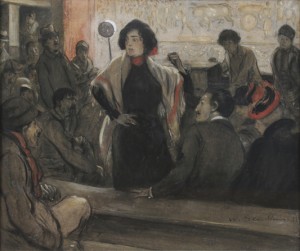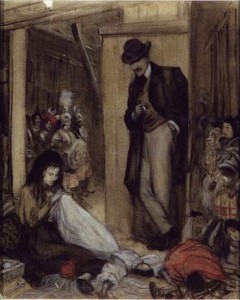William Glackens (1870-1938)
She wheeled about and stamped her foot. “Silence pigs!” she screamed.
Story illustration for “The Play’s the Thing” by Albert W. Vorse in Scribner’s Magazine, v. 26 (Aug. 1899): 171.
Wash, Gouache, and Chinese White
Collection of the Society of Illustrators, 039.002
In the Society of Illustrators permanent collection records, the description that accompanies this illustration is,
Women’s Rights
“She wheeled around and stamped her foot, ‘Silence pigs!’”
Illustration from “The Play’s the Thing”
It is probably next to impossible to look at the above illustration any time from the 1970s through today, and not assume that the standing woman with her hands on her hips looking back indignantly over her shoulder at the men seated behind her isn’t bristling with righteous indignation about her rights as a woman. Especially since the late 1960s women have become increasingly forceful at not being denied their rights. But notice that behind the standing women in the illustration there appears to be some kind of scrim or mural that is supposed to be the focus of the gathered audience. The interpretation that the woman is indignant about her rights as a woman would only be possible if we look only at the image from our time and through our contemporary point of view and did not attempt to look at it as grounded in its story and reflecting the attitudes and opinions of its own time.
The story this illustration and others were created for was written by Albert White Vorse (1866-1910), a Harvard graduate, journalist, and author who wrote fiction for popular magazines. Bert Vorse, as he was known, was married in 1898 to an activist wife who championed the working class. This story, “The Play’s the Thing” was published the year following the Vorse’s marriage. It is about a young (15 year old) Italian-American seamstress and girl of all work, Beatrice, and Pietro, her father and his Italian marionette theatre. The story’s narrator, Harry, is a slightly older gentleman who is determined to win the hand of a pretty, well-heeled young woman named Deborah.
In the story, Beatrice brings two of her father’s puppeteers to blows. Both want to marry her, but Beatrice is interested in neither. For her the only reality is the play. As her father says, “The play is in her head. Life to her is the play.”
Harry brings Deborah to the theatre and to meet the puppeteer’s family. Beatrice assists by translating the scenes to Deborah during the performance. Afterwards, Beatrice is unhappy that Harry appears to love Deborah, so Beatrice attempts to lock Deborah away and keep Harry for herself. Harry breaks down the door and rescues Deborah and later they marry.
It is clear from the story’s text and from the caption for the illustration in Scribner’s, She wheeled about and stamped her foot. “Silence pigs!” she screamed, that Beatrice is indignant that the men seated behind them have disturbed the girl and the good impression she wants to make on Harry and Deborah, guests to the theatre. What has caused Beatrice to yell out so is that during an intermission a stage hand plays the Intermezzo from Cavalleria Rusticana (a later 19th century Italian opera) on a street-piano setting the ruckus in motion. It is interesting that when the story opens on a visit to the theatre the previous year, a sophisticated Harry watches a younger looking Beatrice sewing on an angel puppet for a future performance. The opening words to the story are, “Beatrice was making an angel.” Harry, as the story’s narrator, then places himself into the story, remarking that he was waiting behind stage for her father to come. The illustration of this activity appears on the third page of the story’s text (see below).
William J. Glackens (1870-1938)
Beatrice was making an angel
Illustration for “The Play’s the Thing” by Albert W. Vorse, Scribner’s Magazine, v, 26 (Aug. 1899): 169.
Wash, Gouache, and Chinese White
The Library of Congress, Cabinet of American Illustration
There are two more full page illustrations, five vignettes images and two line drawings Glackens created for the story. This was a good size illustration commission and the softness of Glacken’s drawing technique helps to visually remind us that we are reading about the past. The opening-page line drawing and the end-piece line drawing show the marionette’s stage during use and the tumbled mess of puppets at the end. There are a few stories wrapped into this one story and the very focus of all of it in the theatre and on the stage versus being part of the audience and real life, heightens the drama.
But no matter how you slice it, Beatrice was no crusading suffragette. The story’s end finds Harry and Deborah married and returned to New York after a three-year honeymoon in Europe. Beatrice too is married and hardly recognizable to Harry. With a babe in her now plump arms she introduces Harry to her unremarkable husband.
As you can see it helps to find the gist of the true story rather than believing everything you see–especially when it comes to illustration.
February 6, 2014
By Joyce K. Schiller, Curator, Rockwell Center for American Visual Studies, Norman Rockwell Museum








